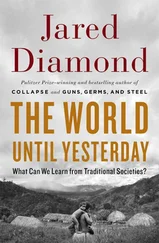Jared Diamond - Guns, Germs & Steel
Здесь есть возможность читать онлайн «Jared Diamond - Guns, Germs & Steel» весь текст электронной книги совершенно бесплатно (целиком полную версию без сокращений). В некоторых случаях можно слушать аудио, скачать через торрент в формате fb2 и присутствует краткое содержание. Жанр: 105. Описание произведения, (предисловие) а так же отзывы посетителей доступны на портале библиотеки ЛибКат.
- Название:Guns, Germs & Steel
- Автор:
- Жанр:
- Год:неизвестен
- ISBN:нет данных
- Рейтинг книги:5 / 5. Голосов: 1
-
Избранное:Добавить в избранное
- Отзывы:
-
Ваша оценка:
- 100
- 1
- 2
- 3
- 4
- 5
Guns, Germs & Steel: краткое содержание, описание и аннотация
Предлагаем к чтению аннотацию, описание, краткое содержание или предисловие (зависит от того, что написал сам автор книги «Guns, Germs & Steel»). Если вы не нашли необходимую информацию о книге — напишите в комментариях, мы постараемся отыскать её.
Guns, Germs & Steel — читать онлайн бесплатно полную книгу (весь текст) целиком
Ниже представлен текст книги, разбитый по страницам. Система сохранения места последней прочитанной страницы, позволяет с удобством читать онлайн бесплатно книгу «Guns, Germs & Steel», без необходимости каждый раз заново искать на чём Вы остановились. Поставьте закладку, и сможете в любой момент перейти на страницу, на которой закончили чтение.
Интервал:
Закладка:
3X8 • GUNS, GERMS. AND STEEL
language group occupying a large, continuous area testify to a recent geographic expansion of that group, such that not enough historical time has elapsed for it to differentiate into many languages. Finally, we can reason conversely that modern areas with a high diversity of languages within a given language family lie closer to the early center of distribution of that language family.
Using those three types of reasoning to turn back the linguistic clock, we conclude that North China was originally occupied by speakers of Chinese and other Sino-Tibetan languages; that different parts of South China were variously occupied by speakers of Miao-Yao, Austroasiatic, and Tai-Kadai languages; and that Sino-Tibetan speakers have replaced most speakers of those other families over South China. An even more drastic linguistic upheaval must have swept over tropical Southeast Asia to the south of China—in Thailand, Myanmar, Laos, Cambodia, Vietnam, and Peninsular Malaysia. Whatever languages were originally spoken there must now be entirely extinct, because all of the modern languages of those countries appear to be recent invaders, mainly from South China or, in a few cases, from Indonesia. Since Miao-Yao languages barely survived into the present, we might also guess that South China once harbored still other language families besides Miao-Yao, Austroasiatic, and Tai-Kadai, but that those other families left no modern surviving languages. As we shall see, the Austronesian language family (to which all Philippine and Polynesian languages belong) may have been one of those other families that vanished from the Chinese mainland, and that we know only because it spread to Pacific islands and survived there.
These language replacements in East Asia remind us of the spread of European languages, especially English and Spanish, into the New World, formerly home to a thousand or more Native American languages. We know from our recent history that English did not come to replace U.S. Indian languages merely because English sounded musical to Indians' ears. Instead, the replacement entailed English-speaking immigrants' killing most Indians by war, murder, and introduced diseases, and the surviving Indians' being pressured into adopting English, the new majority language. The immediate causes of that language replacement were the advantages in technology and political organization, stemming ultimately from the advantage of an early rise of food production, that invading Europeans held over Native Americans. Essentially the same processes accounted for the replacement of Aboriginal Australian languages by English, and of
HOW CHINA BECAME CHINESE • 3^9
subequatorial Africa's original Pygmy and Khoisan languages by Bantu languages.
Hence East Asia's linguistic upheavals raise a corresponding question: what enabled Sino-Tibetan speakers to spread from North China to South China, and speakers of Austroasiatic and the other original South China language families to spread south into tropical Southeast Asia? Here, we must turn to archaeology for evidence of the technological, political, and agricultural advantages that some Asians evidently gained over other Asians.
As everywhere else in the world, the archaeological record in East Asia for most of human history reveals only the debris of hunter-gatherers using unpolished stone tools and lacking pottery. The first East Asian evidence for something different comes from China, where crop remains, bones of domestic animals, pottery, and polished (Neolithic) stone tools appear by around 7500 b.c. That date is within a thousand years of the beginning of the Neolithic Age and food production in the Fertile Crescent. But because the previous millennium in China is poorly known archaeologically, one cannot decide at present whether the origins of Chinese food production were contemporaneous with those in the Fertile Crescent, slightly earlier, or slightly later. At the least, we can say that China was one of the world's first centers of plant and animal domestication.
China may actually have encompassed two or more independent centers of origins of food production. I already mentioned the ecological differences between China's cool, dry north and warm, wet south. At a given latitude, there are also ecological distinctions between the coastal lowlands and the interior uplands. Different wild plants are native to these disparate environments and would thus have been variously available to incipient farmers in various parts of China. In fact, the earliest identified crops were two drought-resistant species of millet in North China, but rice in South China, suggesting the possibility of separate northern and southern centers of plant domestication.
Chinese sites with the earliest evidence of crops also contained bones of domestic pigs, dogs, and chickens. These domestic animals and crops were gradually joined by China's many other domesticates. Among the animals, water buffalo were most important (for pulling plows), while silkworms,
33o " GUNS, GERMS, ANDsteel
ducks, and geese were others. Familiar later Chinese crops include soybeans, hemp, citrus fruit, tea, apricots, peaches, and pears. In addition, just as Eurasia's east-west axis permitted many of these Chinese animals and crops to spread westward in ancient times, West Asian domesticates also spread eastward to China and became important there. Especially significant western contributions to ancient China's economy have been wheat and barley, cows and horses, and (to a lesser extent) sheep and goats.
As elsewhere in the world, in China food production gradually led to the other hallmarks of "civilization" discussed in Chapters 11-14. A superb Chinese tradition of bronze metallurgy had its origins in the third millennium b.c. and eventually resulted in China's developing by far the earliest cast-iron production in the world, around 500 b.c. The following 1,500 years saw the outpouring of Chinese technological inventions, mentioned in Chapter 13, that included paper, the compass, the wheelbarrow, and gunpowder. Fortified towns emerged in the third millennium b.c., with cemeteries whose great variation between unadorned and luxuriously furnished graves bespeaks emerging class differences. Stratified societies whose rulers could mobilize large labor forces of commoners are also attested by huge urban defensive walls, big palaces, and eventually the Grand Canal (the world's longest canal, over 1,000 miles long), linking North and South China, Writing is preserved from the second millennium b.c. but probably arose earlier. Our archaeological knowledge of China's emerging cities and states then becomes supplemented by written accounts of China's first dynasties, going back to the Xia Dynasty, which arose around 2000 b.c.
As for food production's more sinister by-product of infectious diseases, we cannot specify where within the Old World most major diseases of Old World origin arose. However, European writings from Roman and medieval times clearly describe the arrival of bubonic plague and possibly smallpox from the east, so these germs could be of Chinese or East Asian origin. Influenza (derived from pigs) is even more likely to have arisen in China, since pigs were domesticated so early and became so important there.
China's size and ecological diversity spawned many separate local cultures, distinguishable archaeologically by their differing styles of pottery and artifacts. In the fourth millennium b.c. those local cultures expanded geographically and began to interact, compete with each other, and
MOW CHINA BECAME CHINESE • 331
coalesce. Just as exchanges of domesticates between ecologically diverse regions enriched Chinese food production, exchanges between culturally diverse regions enriched Chinese culture and technology, and fierce competition between warring chiefdoms drove the formation of ever larger and more centralized states (Chapter 14).
While China's north-south gradient retarded crop diffusion, the gradient was less of a barrier there than in the Americas or Africa, because China's north-south distances were smaller; and because China's is transected neither by desert, as is Africa and northern Mexico, nor by a narrow isthmus, as is Central America. Instead, China's long east-west rivers (the Yellow River in the north, the Yangtze River in the south) facilitated diffusion of crops and technology between the coast and inland, while its broad east-west expanse and relatively gentle terrain, which eventually permitted those two river systems to be joined by canals, facilitated north-south exchanges. All these geographic factors contributed to the early cultural and political unification of China, whereas western Europe, with a similar area but a more rugged terrain and no such unifying rivers, has resisted cultural and political unification to this day.
Some developments spread from south to north in China, especially iron smelting and rice cultivation. But the predominant direction of spread was from north to south. That trend is clearest for writing: in contrast to western Eurasia, which produced a plethora of early writing systems, such as Sumerian cuneiform, Egyptian hieroglyphics, Hittite, Minoan, and the Semitic alphabet, China developed just a single well-attested writing system. It was perfected in North China, spread and preempted or replaced any other nascent system, and evolved into the writing still used in China today. Other major features of North Chinese societies that spread southward were bronze technology, Sino-Tibetan languages, and state formation. All three of China's first three dynasties, the Xia and Shang and Zhou Dynasties, arose in North China in the second millennium b.c.
Preserved writings of the first millennium b.c. show that ethnic Chinese already tended then (as many still do today) to feel culturally superior to non-Chinese "barbarians," while North Chinese tended to regard even South Chinese as barbarians. For example, a late Zhou Dynasty writer of the first millennium b.c. described China's other peoples as follows: "The people of those five regions—the Middle states and the Rong, Yi, and other wild tribes around them—had all their several natures, which they could not be made to alter. The tribes on the east were called Yi. They had their
Интервал:
Закладка:
Похожие книги на «Guns, Germs & Steel»
Представляем Вашему вниманию похожие книги на «Guns, Germs & Steel» списком для выбора. Мы отобрали схожую по названию и смыслу литературу в надежде предоставить читателям больше вариантов отыскать новые, интересные, ещё непрочитанные произведения.
Обсуждение, отзывы о книге «Guns, Germs & Steel» и просто собственные мнения читателей. Оставьте ваши комментарии, напишите, что Вы думаете о произведении, его смысле или главных героях. Укажите что конкретно понравилось, а что нет, и почему Вы так считаете.










